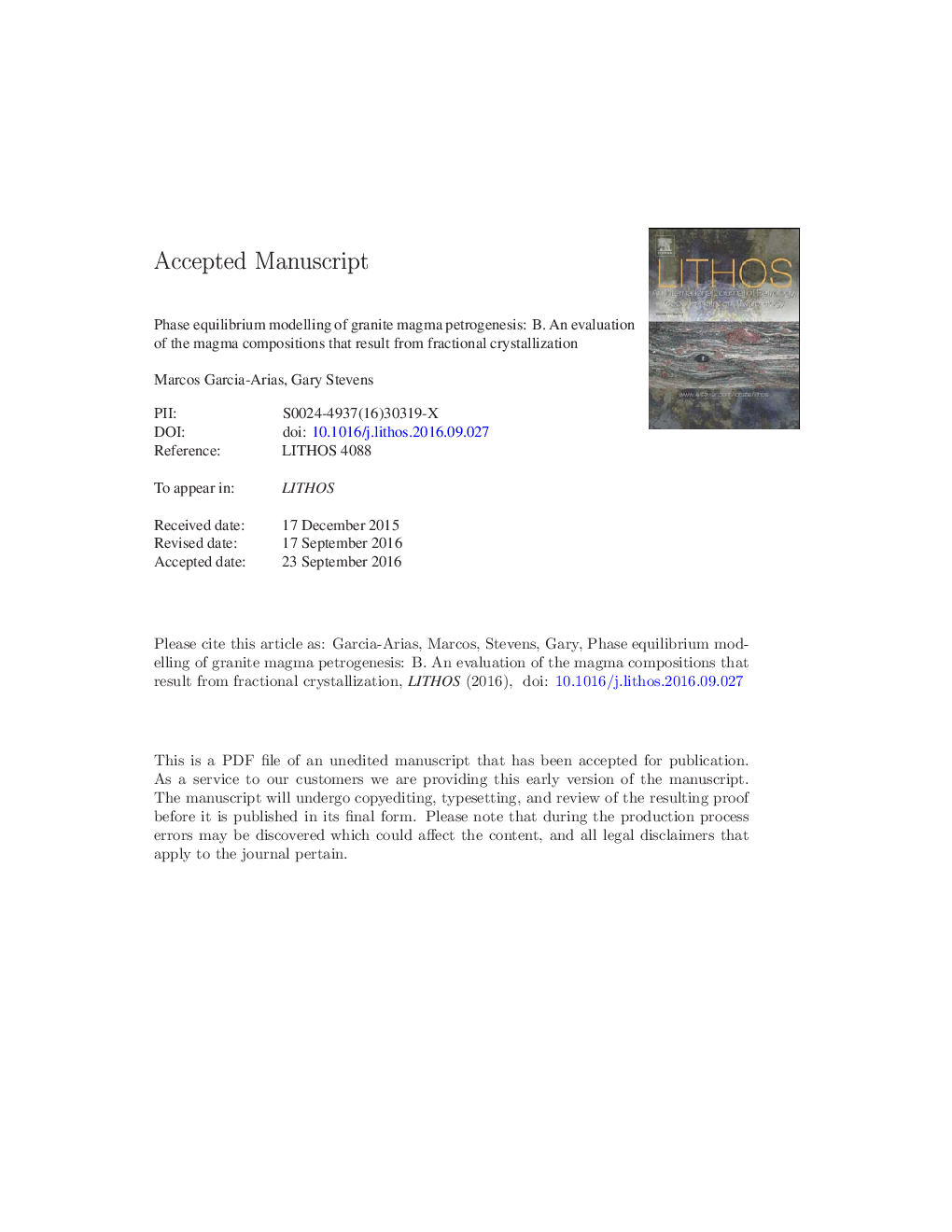| کد مقاله | کد نشریه | سال انتشار | مقاله انگلیسی | نسخه تمام متن |
|---|---|---|---|---|
| 5784083 | 1638633 | 2017 | 66 صفحه PDF | دانلود رایگان |
عنوان انگلیسی مقاله ISI
Phase equilibrium modelling of granite magma petrogenesis: B. An evaluation of the magma compositions that result from fractional crystallization
ترجمه فارسی عنوان
مدل سازی تعادل فاز گرانیت پتروژنز ماگما: ب. ارزیابی ترکیبات ماگما که منجر به کریستالسیون کسر می شود
دانلود مقاله + سفارش ترجمه
دانلود مقاله ISI انگلیسی
رایگان برای ایرانیان
کلمات کلیدی
موضوعات مرتبط
مهندسی و علوم پایه
علوم زمین و سیارات
ژئوشیمی و پترولوژی
چکیده انگلیسی
Several fractional crystallization processes (flow segregation, gravitational settling, filter-pressing), as well as batch crystallization, have been investigated in this study using thermodynamic modelling (pseudosections) to test whether they are able to reproduce the compositional trends shown by S-type granites. Three starting compositions comprising a pure melt phase and variable amounts of entrained minerals (0, 20 and 40Â wt.% of the total magma) have been used to study a wide range of likely S-type magma compositions. The evolution of these magmas was investigated from the segregation from their sources at 0.8Â GPa until emplacement at 0.3Â GPa in an adiabatic path, followed by isobaric cooling until the solidus was crossed, in a closed-system scenario. The modelled magmas and the fractionated mineral assemblages are compared to the S-type granites of the Peninsula pluton, Cape Granite Suite, South Africa, which have a composition very similar to most of the S-type granites. The adiabatic ascent of the magmas digests partially the entrained mineral assemblage of the magmas, but unless this entrained assemblage represents less than 1Â wt.% of the original magma, part of the mineral fraction survives the ascent up to the chosen pressure of emplacement. At the level of emplacement, batch crystallization produces magmas that only plot within the composition of the granites of the Peninsula pluton if the bulk composition of the original magmas already matched that of the granites. Flow segregation of crystals during the ascent and gravitational settling fractional crystallization produce bodies that are generally more mafic than the most mafic granites of the pluton and the residual melts have an almost haplogranitic composition, producing a bimodal compositional distribution not observed in the granites. Consequently, these two processes are ruled out. Filter-pressing fractional crystallization produces bodies in an onion-layer structure that become more felsic with increasing crystallization, culminating in a haplogranitic melt, and is able to reproduce the compositional trends of the granites, but only if the original magmas already had the composition of the granites. Filter-pressing fractionation produces a mineral assemblage that is 1.5 times more mafic than the magma fraction from which it is derived. However, the mineral assemblages produced by crystallization of an originally pure melt phase are still too felsic to account for the bulk of the granites of the Peninsula pluton. For filter-pressing to produce the most mafic granites of the pluton, the original magmas must already contain an entrained mafic mineral assemblage and have the same composition of the granites, otherwise the modelled trends do not match the maficity (FeOÂ +Â MgO) or the slope against maficity of the granites. Crystallization of the magma in filter-pressing releases a free water phase, whose amount depends on the amount of water of the original magma, and whose behaviour may be controlled by a water-saturation front. In summary, the main control in the composition of S-type granites is the amount and nature of the entrained mineral assemblage, and filter-pressing fractional crystallization can only modify slightly the compositions of the granitic bodies derived from these magmas.
ناشر
Database: Elsevier - ScienceDirect (ساینس دایرکت)
Journal: Lithos - Volume 277, 15 April 2017, Pages 109-130
Journal: Lithos - Volume 277, 15 April 2017, Pages 109-130
نویسندگان
Marcos Garcia-Arias, Gary Stevens,
